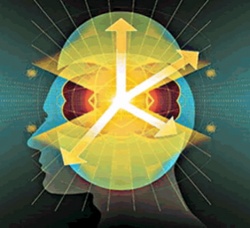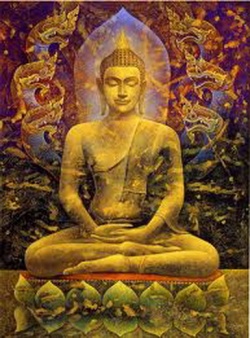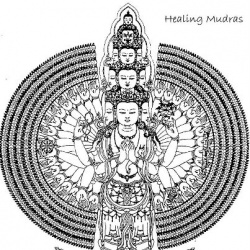Martial Arts: Criticism
For centuries, traditional martial artists have been able to differentiate between the art of the martial arts and the way of the martial arts. They have had the ability to separate, or combine, form and function, similar to the way a body builder is able to pose in an artful, precise way, and then lift heavy weights in a functional way. Some, in an effort to justify the existence of their own “new" or "realistic” martial art, seem to think that this cannot be done, that it must be one or the other. This is must be due to their own personal limitations, since the rest of the martial arts world has no problem in using both the art of their martial art and the way of their martial art.
Most criticism of the martial arts comes from comparing "apples and oranges"; they are both fruit but they are totally different things. You cannot compare the grades of two students in a history class taught in English, when one of the students only speaks French. Critics say, "Look what happens when a traditional no-contact fighter enters a full-contact match and gets slaughtered." It is still a competition match, not a real fight; rules are still used and the full-contact fighter is used to fighting under the rules. What is a combat hardened Marine who is well versed in the LINE combat fighting system steps into the ring with a full-contact fighter using full-contact rules, the LINE fighter would be a disadvantage. However, if the full-contact fighter stepped into a war and attacked the LINE fighter, he would die. The LINE system only trains at stopping and killing the enemy; it is not concerned with punishing him, controlling him, or getting him to surrender. If you want to compare two martial arts, you should use rules that neither help nor hinder either art.
Criticism of patterns
- Differences between techniques used in patterns and those used in sparring
- Most martial artists would agree that the techniques used in patterns are pretty much useless in sparring, but then, that is not the intention of the techniques. Patterns may be physically demanding at times, but the movements and techniques are relatively easy to perform. Patterns are actually intended as a mental exercise not a sparring exercise. Patterns teach mental discipline; being able to concentrate, focus, and perform precise movements while under stressful situations.
- In patterns, everyone must perform stances and techniques the same way
- Since people are not physically, mentally, or emotionally equal, identical techniques do not produce identical results for everyone. This being true, only a few people are capable of performing all techniques with ease. Most people have some techniques they do well and some techniques they may not be able to do at all. In the performance of a pattern, each student is judged on how well he or she performs the pattern using numerous criteria, one of which the use of identical stances and techniques (to judge competitors you must have an established standard to judge by).
Criticism of sparring
- There is difference between sparring and actual fighting techniques
- The claim is that the pursuit of perfection of techniques stifles the learning process; that since fighting does not require perfection, it is useless to waste time on trying to achieve perfection. Many professions train in ways that are different from the ways used during actual use. Police officers carry firearms on the job. Firing range practice (no matter how realistic it is) is not the same as firing at another person, especially when that person is firing at you; however, it is as close as may be accomplished safely. Most police officers will never fire their weapon on the job and most martial artists will never have to defend themselves. Therefore, both are training for something that will probably never occur. Racecar drivers drive with helmets, a seat belt harness, a roll bar, and numerous other safety devices because of the level of danger involved in their driving. The driving public is also exposed to danger in their daily driving but they are not willing to accept the inconvenience of all the extra safety equipment. Not everyone has the same needs or requirements for self-defense. If you are a fighter, then you need to train in fighting. If you are an ordinary person, then you train to spar.
- Punching and kicking in the air is useless. As an example, critics say that professional bodybuilders do not lift air; they use weights since they need weight for resistance to work the muscles and develop their strength. The claim is that the same principal applies to martial arts training, that techniques must be delivered against resistance to achieve any gains. If air training is useless, why do bodybuilders flex their muscles for hours in front of a mirror without weights? Why are professional weight lifters seen on the sidelines performing the lifting motions without weights? Why do professional boxers shadow box? Why do golfers practice imaginary putts in their offices? They do it because it enhances their sports. With no or light-contact sparring, people may spar everyday for a lifetime without serious injury. With heavy or full-contact sparring, people cannot sustain this same level of sparring without serious problems. You do not see many active, alert old professional boxers; blows take a toll. Since most people will never be involved in a fight in their lifetime, is it worth jeopardizing your health for something that probably will never occur? People who always have to “defend” themselves are not average citizens, they have a problem that is unrelated to being an average citizen.
- Controlling techniques means movements "start and stop" with no follow-through and elbows and knees are locked-out when techniques are executed.
- Arms and legs have a limited length, so a kick or punch must stop at some point, and then be brought back so it may start again. This criticism of control is brought up all the time by the “realistic” arts. They pervert it to suit their own agenda. Control means controlling at what point in space the hand or foot is at when it reaches the end of its movement, and this is controlled by range, not by stopping a technique before the end of its movement. A black belt may throw a full power jab that ends just short of a nose or just past the nose. One jab ends in a point in space, the other results in a broken nose. If a jab is “followed through” and it misses, the puncher is vulnerable to a counterattack since the arm is over extended, while a controlled missed jab is merely snapped back to the guard position and ready to attack again.\
- Kicks and punches are not locked out. In training, that could cause repetitive stress injuries to joints. The kick or punch travels until the limb fully extended, but it is not moved the extra millimeters required to lock the knee or elbow joint. In addition, with a lock out, the reaction force from a hit would travel back through the joint and could injury the joint. With a lock out, the arm or leg will be stationary for a few extra milliseconds and could result in the arm or leg being grabbed.
Criticism of no-contact/light-contact sparring
- Critics say no/light-contact sparring is child's play and not realistic. Granted it does not train a fighter to receive full-contact blows, but, contrary to popular belief, it does help train fighters for full-contact fighting. For one thing, full-contact fighters do not train much by full-contact fighting; the body cannot give or take full-contact blows on a daily basis without the fighters wearing a lot of protective padding. When the padding is worn, then the fighting becomes something else than full-contact fighting. In addition, when fighters fight a full-contact match, it takes weeks, if not months, before they can recover enough to fight again. No/light-contact fighters can fight every day.
- Controlled no/light-contact attacks are not substandard or weak; they are merely controlled. When a control puncher hit a hanging, heavy bag with no-contact and then hits it again with full-contact, to an observer, the punches appear exactly alike; the difference is merely a difference of a couple of inches of range. Critics say if a no/light-contact fighter is in a real fight, he or she will not know how to hit hard. Just because a full-contact fighter cannot use precise control, it does not mean that that a no-contact fighter cannot use the same precise control to hit hard. Critics of no/light-contact should not place their own limitations upon others. Just because they cannot control their blows to hit soft, it does not mean that others cannot control their blows to hit hard. It is relatively easy for a no/light contact fighter to hit hard, but it is difficult for a full-contact fighter to hit soft. No/light-contact fighters train to hit soft, and to hit hard, while full-contact fighters only train to hit hard.
- Control is good thing. When I am traveling at 70 mph on an interstate highway and the brake lights of the car in front of me suddenly come on, I do not always slam on the brakes; I react as the conditions warrant. If I sense the car is not slowing or is gradually slowing, I instantly touch the brakes but apply pressure as required. However, if I sense the car is quickly slowing or that the driver has slammed on the brakes, then I may have to slam on the brakes. Always slamming on the brakes is dangerous, controlled breaking is a good thing. Controlled attacks are a good thing. If a woman of small man is attacking you, you must defend yourself, but you must also control your blows. If you do not, you may overreact and hit too hard, causing serious injury or death, and may be criminally or civilly liable.
- When you see a matchup between a no-contact fighter and a full-contact fighter, it is usually under the full-contact rules, which are unfamiliar to no-contact fighters. Conversely, a full-contact fighter would be at a big disadvantage in a no-contact fight. Full-contact fighters enjoy the contact and do no mind getting hit. No-contact fighters do not enjoy getting hit, if they did, they would be full-contact fighters. In a real fight, a no-contact fighter will fight full-contact and take hits as they come because it cannot be avoided. In a match fight with a full-contact fighter, the no-contact fighter can and does hit hard, but he or she does not want to get hit, and thus he or she is tentative in attacks and in "mixing it up;" just as a full-contact fighter would be tentative in attacking in a no-contact match.
There is nothing wrong with full-contact fighting and there is nothing wrong with no-contact fighting. Which one you do all depends on whether you like getting hit or do not like getting hit.
Criticism of blocking
Blocking is ineffective. Some “real” martial art styles think that blocking is useless in a fight. They think that blocks are a recent development used to block full-stop, locked-out punches and kicks and that they are useless against a series of hooks and uppercuts that are delivered with maximum power. Well, they are correct that extended blocks are useless against close-in hand attacks thrown by a skilled fighter. However, when used against long-range kicks or against ordinary thugs and drunks, extended blocks are effective. Very few people will be defending themselves against a skilled fighter. They will be defending against an idiot with a stick, knife, chair, or broken bottle. If you are counting on a bob or weave to protect your head from a stick, you are stupid. You should duck and block at the same time. Close-in blocks from a guard are effective against close-range attacks, which is why boxers use them. Boxers use bobbing and weaving, side stepping, and a tight guard to defend against punches but they do not have to worry about kicks. Extended blocks are useful against kicks, but they are useless against a blitz attack. That is why a taekwondo black belt would not used them under this situation; they would cover and counter.
Criticism of kicking
Critics say kicking above the belt is useless; they point to professional UFC type fights as examples. There you will certainly see many horrible kicking techniques, even from supposedly taekwondo trained fighters. For these types of fights, the fighters train to punch, kick the thighs, and grapple, and many have only trained in this way of fighting. If they ever had good kicks from some other art, they have gone away due to lack of use. Normally, powerful spin side kicks look similar to those seen used by beginning taekwondo students. Most above the belt kicks are done merely for show. There are exceptions, such as "Co Cop" who uses round kicks to the head that constantly knockout opponents. If a skilled taekwondo kicker entered a UFC type match, he or she would be not used to the type of fighting used and would probably be afraid of getting hit, so the his or her kicks would probably be tentative and weak. Good kickers, who train to fight in grappling style matches, use their kicks very effectively in full-contact matches.
Criticism of twisting, full-stop punches
The claim is that since the punch comes to a stop, it lacks power. The claim is that only punches that follow-through the target are effective. Follow-through punches are pushes. Slap someone with a quick, snapping motion and then slap him or her with follow-through slap. In the quick slap, all power is focused on the point of impact. The follow-through slap has no focus; power is spread over the entire length of the motion. The quick slap hurts more. A sparring punch is focused to stop one inch before the target. A fighting punch is focused to stop two inches beyond the target. One scores, the other kills. A jab, straight, or cross punch comes to a stop. A hook or an upper cut gradually ends and comes to a stop as it drawn back to the guard position. All punches and kicks must come to a stop at some point. As to the effectiveness of twist a punch, Mohammed Ali twisted his punches. That is one reason why his opponents had so many cuts.
Criticism of "one Punch-one Kill" philosophy
Critics say this is a false philosophy, that you should not put your faith in one punch stopping an attacker. Well, they are right, and that is why we do not put our faith in one punch stopping an attacker. The one punch-one kill philosophy relates to mental attitude, not a belief that one punch is all that is needed to end a fight. In the "one punch-one kill philosophy," each punch is focused as though it is meant to be the punch that ends the fight, there are no wimp punches when the fight is to the death.
Criticism that most martial arts are useless against a modern weapon
Critics say that since most traditional martial arts are based upon empty hand fighting and that the techniques are ineffective against guns, knives, and impact weapons. This could be true, depending on the instructor. Even if traditional martial arts may be the best choice, they still may be the best choice for people who have a life that is not centered on fighting.
This depends on the instructor of the martial art. If the instructor does not teach weapon defenses, any martial art will have limited effectiveness against a weapon. With proper emphasis by the instructor, any martial art may be effective against a weapon.
Criticism of "no first strike" philosophy
Critics say that the "no first strike" philosophy is suicidal on the street. The philosophy states that you should not initiate the attack. Even the most conservative, hard-core traditionalist does not wait for the first attack when an attack is imminent. However, in other situations, such as in an argument in a bar, you do not attack first just because you think a fight is coming and you want to be the first to attack. You will be wrong and may be criminally or civilly liable. If the person has expressed intent to attack and made some overt action toward carrying out that intent, then you do not, and should not, wait for the first strike.
Criticism of stances
Critics say low fixed stances make you immobile, making quick movements extremely difficult. Again, they are right, that is why they are only used in patterns, where artistic perfection is the goal. When we spar, we use fighting stances that facilitate quick movement, punches, and kicks.
Criticism of breaking
Critics say boards are easy to break and that boards do not fight back. Board breaking is a just way to judge your technique and power. You cannot punch or kick a sparring partner with that much power, so you must use either use a padded heavy bag or a hard, but breakable, object. Performing a hand-held, 4 or more board break, requires tremendous concentration and power. If done properly, there is no injury. If done improperly, there may be injury. Therefore, there is always the chance of injury while breaking; just as it is in an actual fight.
Criticism that traditional martial arts take too long to learn and you still cannot fight!
- Critics say traditional martial arts take too long to learn and they are the least efficient fighting styles. How long is too long if you plan on training for a lifetime? As stated in other places in TKDTutor.com, since traditional arts may be practiced at any age, they are lifetime endeavors that may also be used for self-defense. Traditional arts are not street fighting systems for a select few adults who like to fight. Even if street fighters make it to an old age, it is doubtful they will still be street fighting. Traditional martial arts make you still and rigid
- Critics say traditional martial arts make a student tense and rigid because of all the training with hard air punches and kicks, tense patterns, and deep immovable stances. This is another sweeping generality. Watch a traditional martial arts class or sparring competition to see if this is true.
Criticism of belt ranks
Say what you want, but belts have served a useful purpose in the martial arts for over a hundred years. That is why their use is so widespread. Some say that saying you once earned a black belt is similar to saying you were once a state track champion in high school. After twenty years, are you still a track champion? The answer is yes. A doctorate in zoology is still valid, even if you have spent the last 20 years working as a banker.
Criticism of the "way"
Some criticize those who seek the "do" or "way" of the martial arts. They say we fear being labeled as killers and use the belief as a way to resolve inner conflicts with warfare or to avoid having to fight. All warriors have a code of conduct. If they do not, they are just animals without morals or consciousnesses; they will fight for any reason and usually for the wrong reason.







